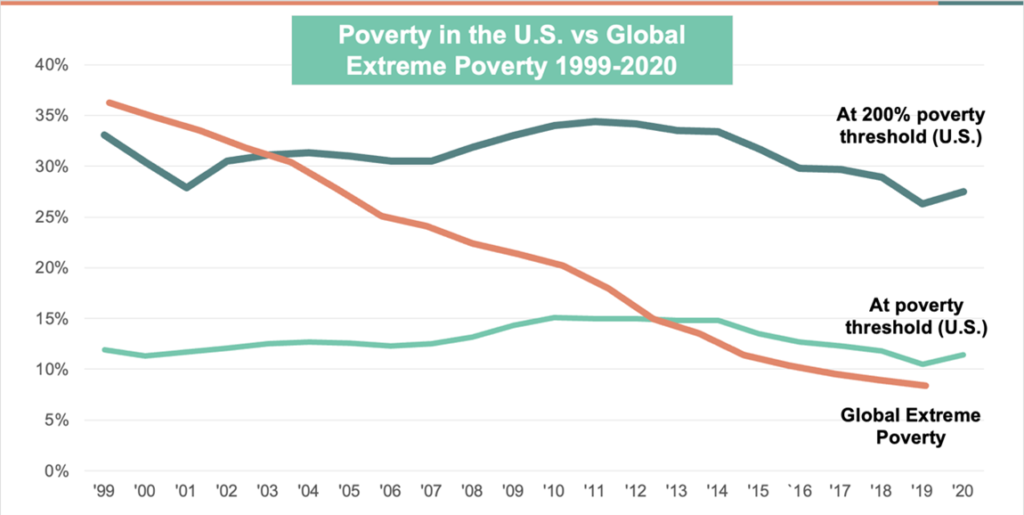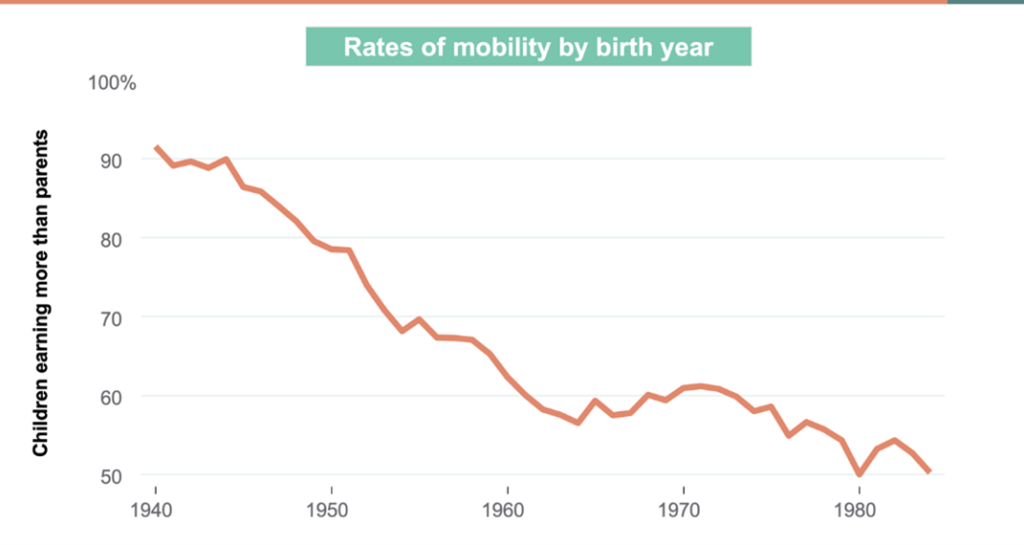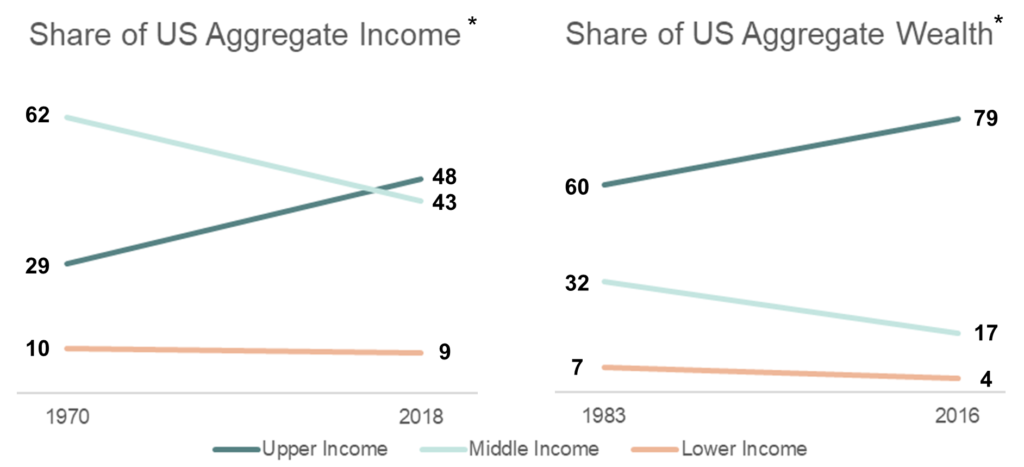Summary
Economic mobility goes to the heart of the founding ideals of the US – a country that has long portrayed itself as a bastion of economic opportunity. As the accuracy of that narrative comes under collective scrutiny, efforts to advance economic mobility in the US have grown.
Initially drawn to the general attractiveness of economic mobility as a social impact issue, many of the stakeholders in this space have been compelled to take action on economic mobility in the face of three longstanding trends: persistently high poverty rates, new evidence of declining economic mobility, and unsustainable levels of wealth concentration. Each of these trends currently limits the prospects of lower- and middle-income individuals and communities ascending the economic ladder. Each trend also allows for a range of stakeholders to engage, by addressing the trends that are most relevant to their unique strategies.
Economic Mobility has become a prominent social issue
From our vantage point as strategic advisors for Shared Prosperity, it is clear that economic mobility has gradually become a more widely stated objective of philanthropic, governmental, and private sector stakeholders in the US, over recent years. The newfound prominence of economic mobility is apparent in the:
- Breakthrough research and analyses emanating from major US universities
- Recommendations and policy initiatives of political leaders, think tanks, and governments at the local, state, and federal levels
- Corporate social responsibility programs of a number of leading US corporations and employers
- Theories of impact of several of the country’s most influential philanthropies, community development finance institutions, and nonprofits.
A small snapshot of just some of the eminent institutions engaged in this area is captured below, purely as a means of illustrating the diversity of organization types involved:

The broad appeal of economic mobility as a focus of social impact efforts is three-pronged:
- First, economic mobility can serve as an overarching connector of various issue areas for those who seek to evolve beyond rigidly siloed social impact funding. For example: while criminal justice reform and employment have often been addressed as distinct issues, framing desirable social outcomes in terms of economic mobility (rather than purely in terms of criminal justice outcomes vs. employment outcomes) has allowed stakeholders to better explore the interrelationship between these two areas, and address both symbiotically. This, in turn, is conducive to more fluid and holistic funding approaches that move beyond traditional, single-issue funding towards innovative, multi-issue funds – such as the Justice and Mobility Fund and the Families and Workers Fund.
- Second, economic mobility is a powerfully non-partisan issue: while political ideology and social agendas do skew beliefs around what might drive economic mobility (and can also influence which of the four measures of economic mobility stakeholders favor), there is broad consensus that economic mobility should be available to all in the US. For this reason, both sides of the political aisle are interested in the growing body of learnings around economic mobility in this country, the most widely covered of which are the work of Opportunity Insights and the Opportunity Atlas of economic mobility across US neighborhoods. This, in turn, can even be conducive to bipartisan policy agendas on economic mobility – California’s nonpartisan Economic Mobility Collaborative is one case-in-point.
- Third, economic mobility is central to the story of the United States: the notion that prosperity is attainable to all those who work diligently in its pursuit is a founding premise of this country. Generations of US-born citizens and immigrants, alike, have been fueled by a mantra that their labor and endeavor should ultimately pay unique dividends for them in the US – allegedly, in the form of greater wealth than may be attainable in other countries and societal recognition of their contributions. Nowhere is this ideal better captured than in James Truslow Adams’ Epic of America (1931), in which he evoked:
“A land in which life should be better and richer and fuller for everyone, with opportunity for each according to ability or achievement. (It is not) “… a dream of motor cars and high wages merely, but a dream of social order in which each man and each woman shall be able to attain the fullest stature of which they are innately capable, and be recognized by others for what they are, regardless of the fortuitous circumstances of birth or position.”
However, these three factors alone do not fully explain the upswing in explicit focus on economic mobility outcomes in the US. They do provide a uniquely strong enabling environment for interest in economic mobility, which is conducive to innovation and collaboration, but they are not the primary drivers of our clients’ engagement in economic mobility. Rather, organizations engaged in increasing economic mobility cite a series of persistent and dissatisfactory economic trends of significant concern to stakeholders of (almost) all ideological persuasions, which intersect to tell a bleak story of economic mobility in the US today.
Economic mobility is undermined by diverse factors that attract a broad spectrum of stakeholders
Multiple analyses over the last decade have evidenced the gradual evisceration of the ‘American Dream’, and with it, the collapse of a core pillar of the social contract and founding narrative of the US. The false narrative of the modern-day US as a place of unbridled opportunity and meritocracy for all people has been laid bare. Its fallacy constrains multiple segments of the population that have long been disempowered economically, perpetuating longstanding inequities for these population segments in the process. It also impedes the country’s so-called ‘middle’ class: a large, and increasingly disenfranchised, constituency that has essentially evaporated over recent decades.
Stakeholders seeking to revive economic mobility are usually responding to one or more of three headline challenges surfaced by recent analyses, all of which impact economic mobility in the US:
1. US poverty rates remain stubbornly high
The US still has the second-highest poverty rate of all OECD countries. The most conservative estimates of poverty, published by the US Census Bureau, have placed the poverty rate at 10-15% each year since the 1990s. These rates are based on a draconian definition of poverty – an income of less than $12,880 in annual income for a single person and $21,960 for a 3-person family. A commonly used alternative measure, which captures all people living on less than 200% of the Census Bureau’s thresholds and provides a more realistic measure of total poverty, shows that a massive 27.5% of the population is experiencing poverty. This rate has remained relatively flat in the last two decades, while conversely, rates of (extreme) poverty globally have fallen dramatically in the same time period. Perhaps the most striking statistic comes from the Federal Reserve: 37% of adults in America would be unable to cover a $400 emergency expense.

High poverty rates impede economic security and stability, which are pre-requisites to economic mobility. Without economic security and stability day-to-day, individuals cannot plan for a brighter future and are deprived of the power and agency on which economic mobility depends (per the findings of the US Partnership on Mobility from Poverty). The practical impact of poverty includes daily economic hardship, reduced social cohesion, and extreme cost to government over the lifetime of an individual. In focusing on poverty alleviation, stakeholders are also engaged, by extension, in advancing economic mobility.
2. US economic mobility is comparatively low, and in sustained decline
While cross-country comparisons of economic mobility depend on data and methodologies that are not always fully aligned in scope and approach, a string of economic studies suggest that the US stands out as having less, not more, intergenerational mobility than a large number of other OECD countries, on both absolute and relative intergenerational measures. (We have previously discussed the varying measures of economic mobility and their relevance. These may be useful to revisit before delving into the commentary below).
On one common research measure (absolute, inter-generational mobility), economic mobility in the US has collapsed over recent decades. The Opportunity Insights research and policy lab has produced the most comprehensive data analysis of US economic mobility to-date. Whereas ~90% of those born in 1940 went on to earn a greater household income than their parents (adjusting for inflation), only ~50% of young adults today can expect to go on to do so. On this measure, economic mobility has fallen across most of the income distribution, with the largest declines for middle class households.
These findings do not change even when using alternative price indices to adjust for inflation; accounting for taxes/transfers; comparing income at later ages in life; or adjusting for changing averages in household size as a result of evolving social norms.

At first glance, the headline takeaway from a relative, inter-generational measure of economic mobility can seem less alarming. On average, this measure of mobility has remained relatively flat since the 1970s: in general, individuals entering the labor market today are likely to end up in the same income quintile as their parents (at an equivalent age and adjusting for inflation).
However, when combined with the insights we have on absolute, inter-generational mobility (presented above), the reasons for the apparent steadiness in relative measures of economic mobility becomes clearer: although fewer and fewer individuals are now matching their parents’ income level – which we might logically assume would lead them to fall into lower income quintiles – this decline is so widespread across those in the middle income quintile and lower income quintiles, that individuals are not ‘swapping places’ relative to one another. All are sinking together. By extension, most are therefore maintaining a steady position in the income distribution relative to others.
While the full reasons for this are multifaceted, a summary explanation may be that the fruits of the prosperity (i.e. the economic growth) generated by the US since the 1940s have not been shared as evenly over recent decades as they once were. Many point to policy choices that took root in the 1970s, and then multiplied across successive Democrat and Republican administrations, as one probable cause – which ties neatly into the next point below.
3. Prosperity has grown untenably concentrated
As the latest income and wealth inequality data attests: the (mean) average wealth of families in the US is no higher now than it was two decades ago. This is not promising, in and of itself, nor is it indicative of a truly open economy based on equality of economic opportunity.
More worryingly, perhaps, the wealth divide between upper-income families and middle- and lower-income families is acute and has grown continually since the 1980s. Upper-income families are the only category that grew their wealth from 2001 to 2016, by an average of 33%. In contrast, the wealth of middle-income families contracted by an average of 20% over the same period, and lower-income families have seen their wealth implode by an average of 45%. As a result, upper-income families now hold around 7 times the wealth of middle-income families and 75 times the wealth of lower-income families. These ratios are respectively double and triple what they were in 1983.
With such concentration of prosperity comes concentration of power. The ongoing rise in inequality appears to have caused economic opportunity and mobility to continue to diminish, per what is known as The Great Gatsby Curve. Growing inequality has also been shown to subdue the political influence of the economically disadvantaged (while affording the most wealthy direct influence on policy and lawmaking), support deepening geographic segregation of households according to income, and potentially stifle the economic growth on which future prosperity depends.

The confluence of these issues allows for a cross-section of stakeholders to engage
In short, there are therefore many factors spurring the resurgence in interest in economic mobility from stakeholders in all sectors. The general attractiveness of economic mobility is that it provides a useful frame for making non-siloed social impact investments; transcends political divides as a subject of concern; and resonates as a key objective for all those living in the US, thanks to its relevance to the founding story of this country. These are the “carrots” that make it especially appealing for stakeholders to track economic mobility.
The “sticks” that have ultimately compelled stakeholders to take action are: the stubborn poverty rate; declining economic mobility that cannot be concealed simply by picking a more convenient measure of mobility; and unsustainable levels of wealth concentration – all of which contribute to the crisis in economic mobility in the US at present.
The diversity of contributing issues allows for a diversity of stakeholders to engage. Those focused on economic insecurity and instability typically cite poverty rates as their chief concern; those focused on economic opportunity writ large are often responding to the economic mobility data; while those who seek to evolve our economic paradigms, including the economic dignity and sense of belonging of lower-income constituencies, will often be most concerned with the data on wealth inequality. All are ultimately contributing to efforts to increase economic mobility, albeit through different entry points into the issue.
In our next article, we’ll look at how to make sense of the economic mobility space in the US in terms of its three (primary) constituent fields, before exploring opportunities to strengthen each of these fields in the years ahead. Read our previous article here.
Other articles in this series:
Which Measure Of Economic Mobility Is Right For Your Organization?
